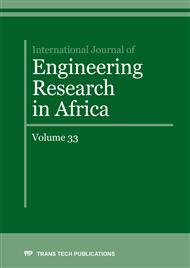[1]
S.S. Sidhu, A. Batish, S. Kumar; Study of Surface Properties in Particulate-Reinforced Metal Matrix Composites (MMCs) Using Powder-Mixed Electrical Discharge Machining (EDM),; Materials and Manufacturing Processes, Vol. 29, (2014), PP. 46–52.
DOI: 10.1080/10426914.2013.852211
Google Scholar
[2]
A.K. Singh, S. Kuma, V.P. Singh; Optimization of Parameters Using Conductive Powder in Dielectric for EDM of Super Co 605 with Multiple Quality Characteristics,; Materials and Manufacturing Processes, Vol. 29, ( 2014), PP. 267-273.
DOI: 10.1080/10426914.2013.864397
Google Scholar
[3]
M. Hourmand, S. Farahany, A.A.D. Sarhan, M.Y. Noordin; Investigating the electrical discharge machining (EDM) parameter effects on Al-Mg2Si metal matrix composite (MMC) for high material removal rate (MRR) and less EWR–RSM approach,; The International Journal of Advanced Manufacturing Technology, Vol. 77, No. 5-8, (2014).
DOI: 10.1007/s00170-014-6491-2
Google Scholar
[4]
V. Gohil, Y.M. Puri; Turning by electrical discharge machining: A review,; Proceedings of the Institution of Mechanical Engineers, Part B: Journal of Engineering Manufacture 2015, published online before print. doi: 10. 1177/0954405415590560.
DOI: 10.1177/0954405415590560
Google Scholar
[5]
F. Klocke, M. Holsten, L. Hensgen, A. Klink; Experimental Investigations on Sinking-EDM of Seal Slots in Gamma-TiAl,; Procedia CIRP, Vol. 24, (2014), PP. 92-96.
DOI: 10.1016/j.procir.2014.07.143
Google Scholar
[6]
M. Thomas, M.P. Bacos; Processing and characterization of TiAl based alloys: towards an industrial scale,; Aerospace Lab Journal, Vol. 3, (2011), PP. 1-11.
Google Scholar
[7]
L. Settineri, P.C. Priarone, M. Arft, D. Lung, T. Stoyanov; An evaluative approach to correlate machinability, microstructures, and material properties of gamma titanium aluminides,; CIRP Annals - Manufacturing Technology, Vol. 63, No. 1, (2014).
DOI: 10.1016/j.cirp.2014.03.068
Google Scholar
[8]
H. Kokubo, H. Takezawa, K. Horio, N. Mohri, T. Yamazaki; A study on the material removal mechanism in EDM-single discharge experiments with low melting temperature alloy,; In ASPE Annual Meeting, USA Orlando, Florida, Paper no. 1564, 24-29 October, (2004).
Google Scholar
[9]
G. Kibria, B.R. Sarkar, B.B. Pradhan, B. Bhattacharyya; Comparative study of different dielectrics for micro-EDM performance during microhole machining of Ti-6Al-4V alloy,; International Journal Of Advanced Manufacturing Technology, Vol. 48, (2010).
DOI: 10.1007/s00170-009-2298-y
Google Scholar
[10]
X. Wang, Z. Liu, R. Xue, Z. Tian, Y. Huang; Research on the influence of dielectric characteristics on the EDM of titanium alloy,; International Journal Of Advanced Manufacturing Technology, Vol. 72, No. 5-8, (2014), PP. 979-987.
DOI: 10.1007/s00170-014-5716-8
Google Scholar
[11]
G. Gautier, P.C. Priarone, S. Rizzuti, L. Settineri, V. Tebaldo; A contribution on the modelling of wire electrical discharge machining of a γ-TiAl alloy,; Procedia CIRP, Vol. 31, (2015), PP. 203-208.
DOI: 10.1016/j.procir.2015.03.019
Google Scholar
[12]
B. Jabbaripour, M.H. Sadeghia, M.R. Shabgard, H. Faraji; Investigating surface roughness, material removal rate and corrosion resistance in PMEDM of γ-TiAl intermetallic,; Journal of Manufacturing Processes, Vol. 15, (2013), PP. 56-68.
DOI: 10.1016/j.jmapro.2012.09.016
Google Scholar
[13]
B. Jabbaripour, M.H. Sadeghi, M.R. Shabgard, Sh. Shajari, H. Hassanpour; Investigating the Effects of Powder Mixed Electrical Discharge Machining on the Surface Quality of γ–TiAl Intermetallic,; Advanced Materials Research, Vol. 488-489, (2012).
DOI: 10.4028/www.scientific.net/amr.488-489.396
Google Scholar
[14]
S A.R.C. harman, D.K. Aspinwall, R.C. Dewes, P. Bowen; Workpiece surface integrity considerations when finish turning gamma titanium aluminide,; Wear, Vol. 249, No. 5-6, (2001) PP. 473–481.
DOI: 10.1016/s0043-1648(01)00575-0
Google Scholar
[15]
A. Beranoagirre, L.N.L. Lacalle; Milling of gamma TiAl intermetallic alloys,; American Institute of Physics, Vol. 43, (2009), PP. 526-532.
DOI: 10.1063/1.3273661
Google Scholar
[16]
M.C. Kong, D. Axinte, W. Voice; Aspects of material removal mechanism in plain water jet milling on gamma titanium aluminide,; Journal of Materials Processing Technology, vol. 210, No. 3, (2010), PP. 573–584.
DOI: 10.1016/j.jmatprotec.2009.11.009
Google Scholar
[17]
D.K. Aspinwall, R.C. Dewes, A.L. Mantle; The Machining of γ-TiAl Intermetallic Alloys,; CIRP Annals Manufacturing Technology, Vol. 54, No. 1, (2005), PP 99-104.
DOI: 10.1016/s0007-8506(07)60059-6
Google Scholar
[18]
Biswal, S., Basic electronics, Atlantic Publishers and Distributors, India, Dehli 2001, 272 pp.
Google Scholar
[19]
Nanu, D.; Diaconescu, C.; Vesa, E. Modeling the effect of alternative voltage pulses on the dielectric liquid during the pre-ignition phase in EDM, Nonconventional Technology Review 2011, 4, 21-24.
Google Scholar
[20]
D.R. Lide, CRC handbook of chemistry and physics, National Institute of Standards and Technology, USA (2000).
Google Scholar
[21]
H. Clemens, H. Kestler; Processing and Applications of Intermetallic γ-TiAl-Based Alloys,; Advanced Engineering Materials, Vol. 2, No. 9, (2000), PP. 551-570.
DOI: 10.1002/1527-2648(200009)2:9<551::aid-adem551>3.0.co;2-u
Google Scholar
[22]
A.A. Khan; Role of heat transfer on process characteristics during electrical discharge machining,; Developments in Heat Transfer, Book chapter 21, 2011, PP. 417-436.
DOI: 10.5772/21090
Google Scholar
[23]
D.A. Khan, M. Hameedullah; Effect of tool polarity on the machining characteristics in electric discharge machining of silver steel and statistical modeling of the process,; International Journal of Engineering Science and Technology, Vol. 3, No. 6, (2011).
Google Scholar
[24]
C.H. Bai, C.H. Koo; Effects of kerosene or distilled water as dielectric on electrical discharge alloying of super alloy Haynes 230 with Al–Mo composite electrode,; Surface Coating Technology, Vol. 200, No. 12-13, (2006), PP. 4127 – 4135.
DOI: 10.1016/j.surfcoat.2005.03.022
Google Scholar
[25]
F.H. Fores; Titanium aluminides science, technology, applications and syntheses by mechanical alloying,; Journal of Materials Science and Technology, Vol. 10, No. 4, (1994), PP. 251-262.
Google Scholar


